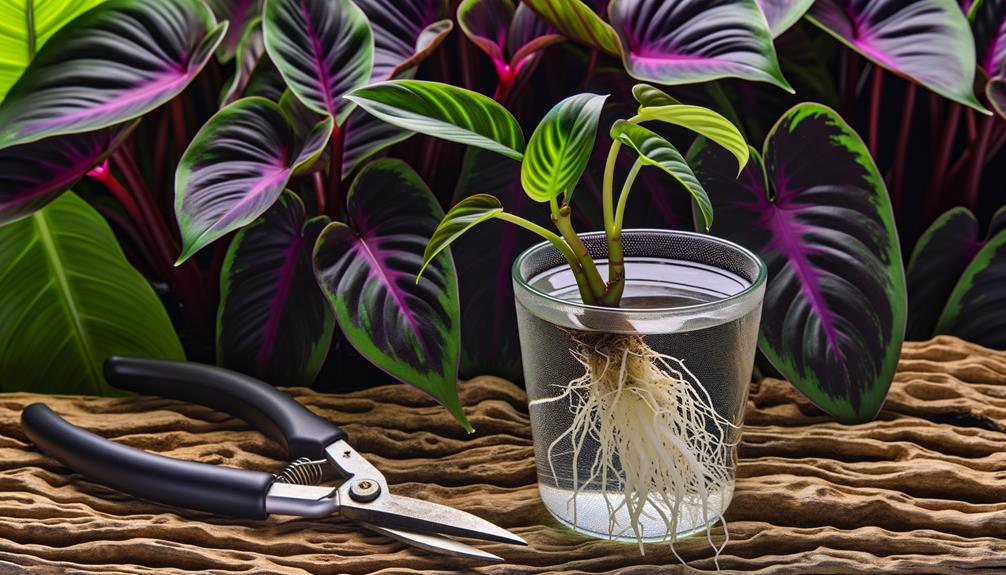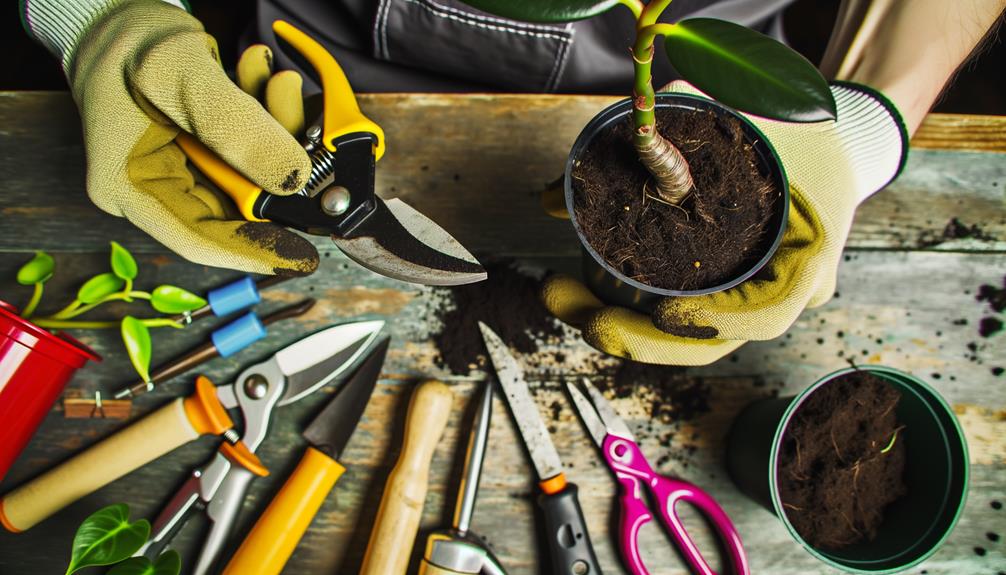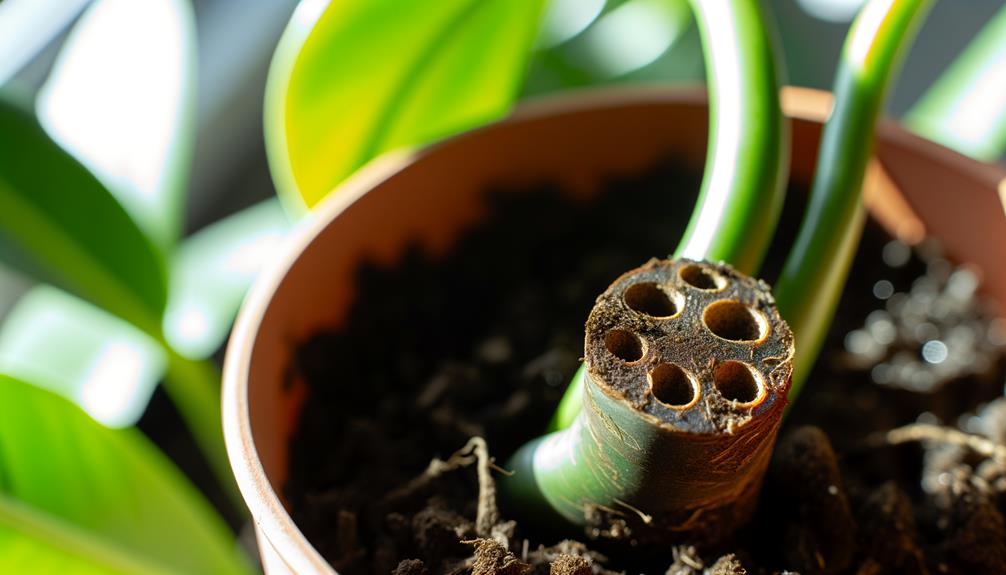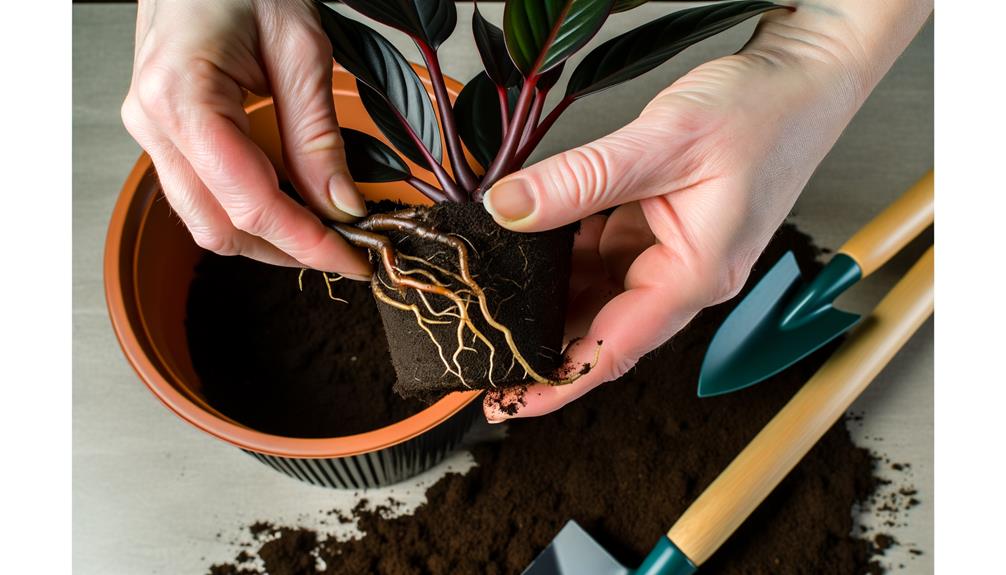5 Simple Steps to Propagate Your Philodendron Black Cardinal
To propagate Philodendron Black Cardinal, begin by sterilizing pruning shears and selecting a healthy, deep green stem with multiple nodes. Make a clean cut just below a node using sharp tools.
Choose between rooting in water or soil. For water propagation, submerge the node in distilled water, refresh every 5-7 days, and expose to indirect light.
For soil, use a well-draining mix and maintain moisture. Ensure environmental parameters such as bright, indirect light and humidity between 60-80%.
Monitor for signs of new growth as an indication of successful rooting. Following these steps will promote prime propagation conditions.

Key Takeaways
- Use sterilized pruning shears to cut a healthy stem with at least one node and two to three leaves.
- Submerge the node in distilled water, changing the water every 5-7 days, and place in bright, indirect light.
- Alternatively, plant the node 1-2 inches deep in a well-draining potting mix and keep the soil consistently moist.
- Maintain humidity levels between 60-80% and temperatures between 18-27°C (65-80°F) for optimal growth.
- Transplant to a slightly larger pot with good drainage once roots are well-established, and water thoroughly to settle the soil.
Gather Your Supplies

To successfully propagate a Philodendron Black Cardinal, you will need to gather the following necessary supplies:
- A sterilized pair of pruning shears or scissors
- A clean container with drainage holes
- High-quality potting mix
- Rooting hormone
- Water
Sterilization of cutting tools mitigates the risk of pathogenic contamination, ensuring a healthy propagation process. The container should facilitate adequate drainage to prevent waterlogging, which can lead to root rot. Opt for a well-draining potting mix to provide ideal aeration and moisture retention.
Rooting hormone enhances the likelihood of successful root development by stimulating cell differentiation at the cut site. Lastly, ensuring a consistent supply of water is essential for maintaining cellular turgor pressure and supporting metabolic activities during the initial stages of root formation.
Select a Healthy Stem
Identifying a strong and disease-free stem is crucial to the successful propagation of Philodendron Black Cardinal. Select a stem that is robust, displaying no signs of wilting, discoloration, or structural damage. Ideal candidates typically exhibit a rich, deep green coloration, indicative of prime chlorophyll content and effective photosynthesis.
Optimum candidates typically exhibit a rich, deep green coloration, indicative of prime chlorophyll content and effective photosynthesis. Verify the stem has multiple nodes, as these are crucial for root formation in subsequent stages.
Avoid stems with any visible pathogens, such as fungal spots or pest infestations, as these can hinder rooting and overall plant health. Additionally, confirm that the chosen stem is neither too young nor overly mature; intermediate age ensures sufficient nutrient reserves and cellular activity conducive to propagation success.
Make the Cut

To start the propagation process, choose a strong stem showing at least one node and numerous healthy leaves.
Using sterile, sharp cutting tools is crucial to prevent the introduction of pathogens and promote a clean incision.
This practice minimizes harm to the plant and encourages ideal rooting conditions.
Choose Healthy Stem
Select a sturdy stem with at least two to three nodes and healthy foliage to guarantee successful propagation. This selection process is essential as it ensures the cutting will have sufficient energy reserves and growth points to develop roots and new leaves.
Examine the stem meticulously, making sure there are no signs of disease or pest infestation. The leaves should be vibrant, indicating that the stem is thriving and capable of sustaining itself during the rooting process.
Here are three key aspects to keep in mind:
- Node Quantity: Check that the stem has multiple nodes to enhance rooting potential.
- Foliage Health: Choose stems with vibrant, unblemished leaves for optimal energy storage.
- Stem Integrity: Select stems free from physical damage or discoloration, indicating strong health.
These steps maximize the likelihood of successful propagation.
Use Sterile Tools
Ensuring your cutting tools are sterilized is critical to prevent the introduction of pathogens that could compromise the health of your Philodendron Black Cardinal. Sterilization can be achieved through various methods, including the use of isopropyl alcohol or a diluted bleach solution (1 part bleach to 9 parts water).
Dip the blades of your pruning shears or knife into the sterilizing solution for 30 seconds, then allow them to air dry. This process eliminates bacteria, fungi, and viruses that may be present. It is advisable to repeat this sterilization procedure between each cut to maintain sterility.
Prepare the Cuttings
To guarantee successful propagation of the Philodendron Black Cardinal, start by selecting healthy stems with vigorous growth. Carefully trim the stem just below a node, as this is where root development will initiate.
Utilize sterilized tools to prevent contamination and promote best rooting conditions.
Select Healthy Stems
Identifying robust and disease-free stems is crucial for successful propagation of Philodendron Black Cardinal. Selecting the right stems promotes excellent growth and reduces the risk of disease transmission.
Here are the key criteria to guide your selection:
- Vigor and Health: Choose stems that are sturdy, lively in color, and free from blemishes or signs of disease.
- Leaf Configuration: Select stems with at least two to three healthy leaves, which indicates sufficient photosynthetic capability to support new growth.
- Node Presence: Make sure the stem has visible nodes, as these are crucial points from which new roots will develop.
Trim Below Node
After selecting strong and disease-free stems, the next step involves making accurate cuts just beneath the nodes to prepare the cuttings for propagation. Nodes are crucial as they contain the meristematic tissues necessary for root development. Guaranteeing the cuts are made just below the node maximizes the potential for successful rooting by exposing the ideal tissue for root initiation. Below is a detailed table outlining the steps and considerations for trimming beneath the node:
| Step | Action | Purpose |
|---|---|---|
| Locate Node | Identify the node on the selected stem | Ensure correct cut positioning |
| Position Cut | Place cutting tool just beneath the node | Maximize exposure of meristematic tissue |
| Angle Cut | Cut at a 45-degree inclination | Increase surface area for rooting |
| Monitor | Check for clean, precise cuts | Prevent disease and support health |
This thorough preparation is crucial for successful propagation.
Use Clean Tools
Securing the use of sterilized cutting tools is crucial to prevent the introduction of pathogens during the propagation process. Contaminated tools can harbor bacteria, fungi, and viruses that may infect the plant tissues, leading to propagation failure. It is vital to disinfect your tools thoroughly before making any cuts.
To effectively sterilize tools, follow these steps:
- Cleaning: Eliminate any visible dirt or plant residue using soap and water.
- Disinfecting: Immerse or wipe the tools with a 70% isopropyl alcohol solution or a 10% bleach solution for 5-10 minutes.
- Drying: Allow the tools to air dry completely before usage to secure no moisture carries pathogens.
Adhering to these steps will notably boost the success rate of your propagation efforts.
Choose a Propagation Method

Selecting the appropriate propagation method for Philodendron Black Cardinal is essential for ensuring successful growth and development. There are primarily two methods to contemplate: stem cuttings and air layering.
Stem cuttings involve selecting a healthy stem with at least one node and a few leaves, then placing it in a suitable medium for root development. This method is relatively straightforward and commonly used.
Air layering, however, requires a more intricate procedure where a section of the stem is wounded, treated with rooting hormone, and wrapped in moist sphagnum moss until roots develop. Each method has its advantages; stem cuttings offer simplicity, while air layering generally yields a larger, more established plant.
Understanding these techniques aids in selecting the most effective propagation strategy.
Rooting in Water
When propagating Philodendron Black Cardinal, rooting in water is an effective technique that involves submerging the stem cutting's node in water to stimulate root formation. The process begins by selecting a healthy stem with at least one node and cutting it just below this node.
Place the cutting in a clean container filled with water, making sure the node is fully submerged.
Key considerations include:
- Water Quality: Use distilled or rainwater to avoid harmful chemicals found in tap water.
- Light Conditions: Position the container in bright, indirect light to promote root growth.
- Water Change Frequency: Refresh the water every 5-7 days to prevent stagnation and bacterial growth.
These steps ensure ideal conditions for root development, leading to successful propagation.
Rooting in Soil

Rooting Philodendron Black Cardinal in soil involves placing the stem cutting with a node directly into a well-draining potting mix to initiate root development. The potting mix should ideally be composed of peat moss, perlite, and vermiculite to guarantee adequate aeration and moisture retention. When inserting the cutting, make sure that the node is buried approximately 1-2 inches deep. Maintain consistent soil moisture without waterlogging to prevent rot. Position the cutting in indirect light to facilitate photosynthesis while minimizing stress.
| Component | Purpose | Ratio |
|---|---|---|
| Peat Moss | Retains moisture | 2 parts |
| Perlite | Enhances aeration | 1 part |
| Vermiculite | Improves drainage | 1 part |
Monitoring the cutting for new growth is crucial, as this indicates successful root establishment.
Provide Proper Care
Once the Philodendron Black Cardinal has established roots, providing proper care is essential to guarantee vigorous growth and overall plant health. Necessary care practices include:
- Ideal Light Conditions: Ensure the plant receives indirect, bright light. Avoid direct sunlight, which can scorch the foliage. Inadequate light can lead to leggy growth and dull leaf coloration.
- Watering Routine: Maintain consistent soil moisture without waterlogging. Water when the top inch of soil feels dry. Overwatering can lead to root rot, while underwatering can cause leaf browning.
- Humidity and Temperature: Maintain humidity levels between 60-80% and temperatures between 18-27°C (65-80°F). High humidity supports lush growth, while temperatures outside this range can stress the plant.
Following these guidelines will establish an ideal environment for your Philodendron Black Cardinal.
Transplant the New Plant

To transplant the new Philodendron Black Cardinal, carefully select a pot that is slightly larger than the current one and confirm it has adequate drainage. Begin by filling the bottom of the new pot with a suitable potting mix, designed for aroids. Gently remove the plant from its current container, making certain you do not damage the root system. Place the plant in the center of the new pot, then fill in around the roots with additional potting mix, firming it gently. Water the plant thoroughly to help settle the soil around the roots.
| Step | Description |
|---|---|
| Select Pot | Choose a pot with good drainage |
| Prepare Potting Mix | Use a mix suitable for aroids |
| Remove Plant | Carefully extract plant from old pot |
| Position Plant | Center plant in new pot |
| Water Thoroughly | Confirm soil is moist and settled |
Conclusion
The propagation of Philodendron Black Cardinal involves several precise steps:
- Gathering materials
- Selecting a robust stem
- Making an accurate cut
- Preparing the cuttings
Choosing between water and soil for rooting, each method demands specific care to guarantee successful root development.
Finally, proper care must be maintained until transplantation.
Following these meticulous procedures guarantees that the new plant thrives, illustrating the idea that 'a stitch in time saves nine,' by preventing future complications through careful initial efforts.






